Inventory Management
- A process of moving inventory within and between locations;
- Requires control on a daily basis;
- Inventory management processes → better decisions;
- Inventory management processes → increased capabilities of solving arising challenges;
- Software can help in managing inventory challenges (Fishbowl, 2018).
The concept of inventory management has captured the attention of manufacturers due to the need of optimizing the flow of materials from one location to another. Inventory management is a process that implies daily control in order to increase the capabilities of businesses in overcoming the challenges that limit productivity and contribute to increased costs of production. It is essential to mention that software that has inventory management options is likely to reduce the time necessary for forecasting and planning as well as facilitate the process of manufacturing optimization.
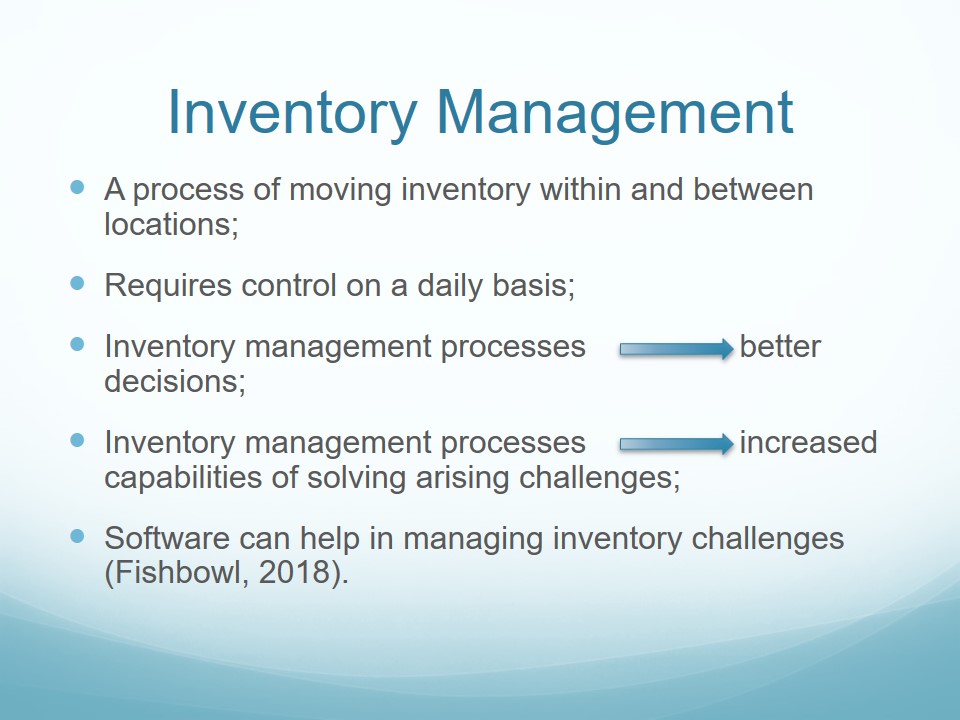
Best Practices of Inventory Management
- Determining the appropriate type of inventory management (e.g., periodic, continuous);
- Implementing cycle counting programs (Marion, 2016);
- Managing inventory levels;
- Implementing quality control for customer satisfaction (Vinson, 2016);
- Optimizing inventory based on needs and challenges;
- Preparing for future business growth.
When a business decides to implement inventory management, there is a list of recommended practices that they can use. These practices range from being prepared for the future growth of a business to integrating cycle counting programs that lead to the enhancement of productivity. Within the context of inventory management, manufacturers can achieve improved levels of quality control to satisfy customers and make sure that they return to make new orders. Best practices of inventory management can range based on businesses’ needs; although, they all imply inventory optimization.
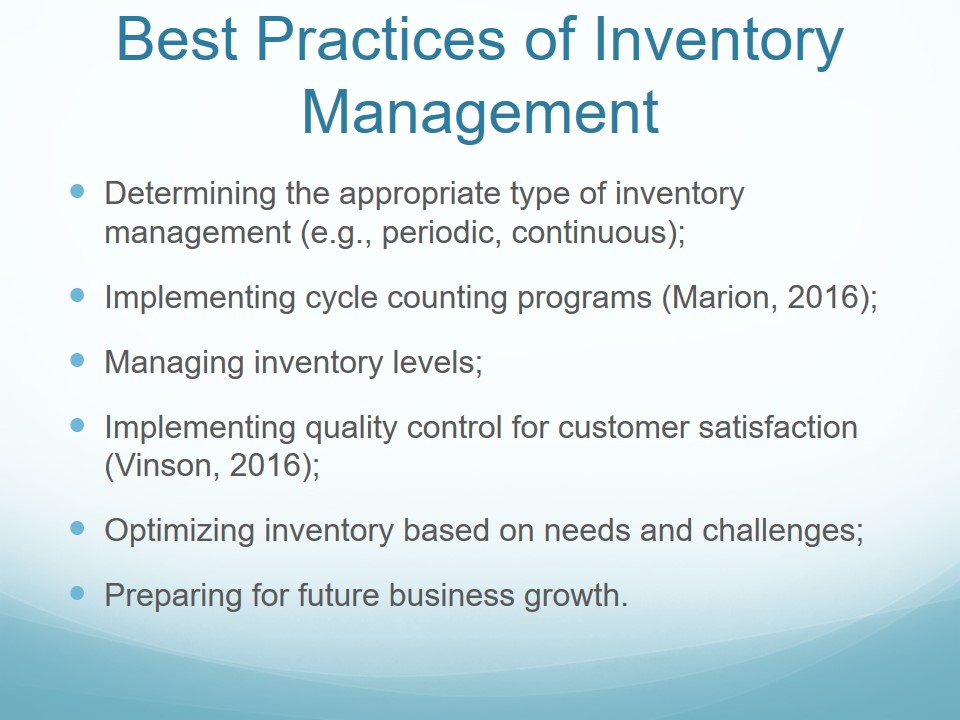
Best Inventory Management for Manufacturing
- Barcode scanners → automatic collection of data on inventory in large manufacturing units;
- Inventory management software → control not only quantity but also quality of inventory;
- Software → organizing cycle documents for better streamlining and making customers’ orders visible digitally;
- Combining software with wireless tools (e.g., scanners, tablets, smartphones) → reducing the likelihood of inventory loss or theft.
- KPIs (demand fluctuations, cost of resources, availability of resources) → ensure the smooth process of manufacturing;
- Inventory system → manage data for making forecast on materials and end product demands;
- Software solution → forecasting seasonal requirements from regular clients;
- Planning resources → ensure that the necessary resources are available when needed.
- Materials planning and forecasting → ensure that the manufacturing plant does not run out of materials;
- Inventory software → fulfill expectations regarding manufacturing;
- Lean inventory → as a guiding strategy for managing inventory in a warehouse or manufacturing plant.
Lean Management of Inventory: Questions to Answer
- What does the business do successfully?
- Are shelves stocked/or is freight pulled when needed?
- Is on-demand technology implemented?
- Is waste eliminated based on data collection?
- Are improvements implemented continuously to achieve perfection?
This slide includes a list of recommended practices that can improve the process of inventory management for manufacturers. It is recommended for businesses to use as much technology as possible in order to avoid human error and protect against fraud or theft. For instance, manufacturers can combine software with wireless tools such as barcode scanners or tablets to monitor inventory levels and optimize the process of data collection to make it faster and easier.
The use of inventory management systems within manufacturing allows businesses to be smart about measuring their KPIs and therefore ensuring a smooth process of production. When inventory systems are developed correctly, they have potential to make data management easier and thus more efficient when it comes to making forecasts on raw materials and end products. Also, inventory management is likely to make forecasts on seasonal demand for making sure that the necessary resources are available when they are needed to be used in the process of production.
It is recommended to use lean inventory management as a guiding strategy for managing inventory in a warehouse or manufacturing plant. Lean inventory is beneficial due to its implications of enhancing the value of the business through the elimination of waste and making sure that the management efforts are targeted at the achievement of perfection (Heizer & Render, 2011). Therefore, this strategy will make sure that the manufacturing plant does not run out of materials and that inventory software will fulfill manufacturing expectations. In manufacturing, lean inventory can bring more benefits than just-in-time because it implies the continuous flow of materials.
When using lean inventory management in the context of manufacturing, there are several questions that companies must ask in order to ensure an efficient implementation of forecasting technologies. The questions presented in the slide are all associated with assessing the benefits and the negative points of manufacturing for the purpose of optimization. By answering questions such as “Is waste eliminated based on data collection?”, the management of a manufacturing department will be able to make informed decisions about materials planning and the elimination of waste that leads to increased costs for businesses.
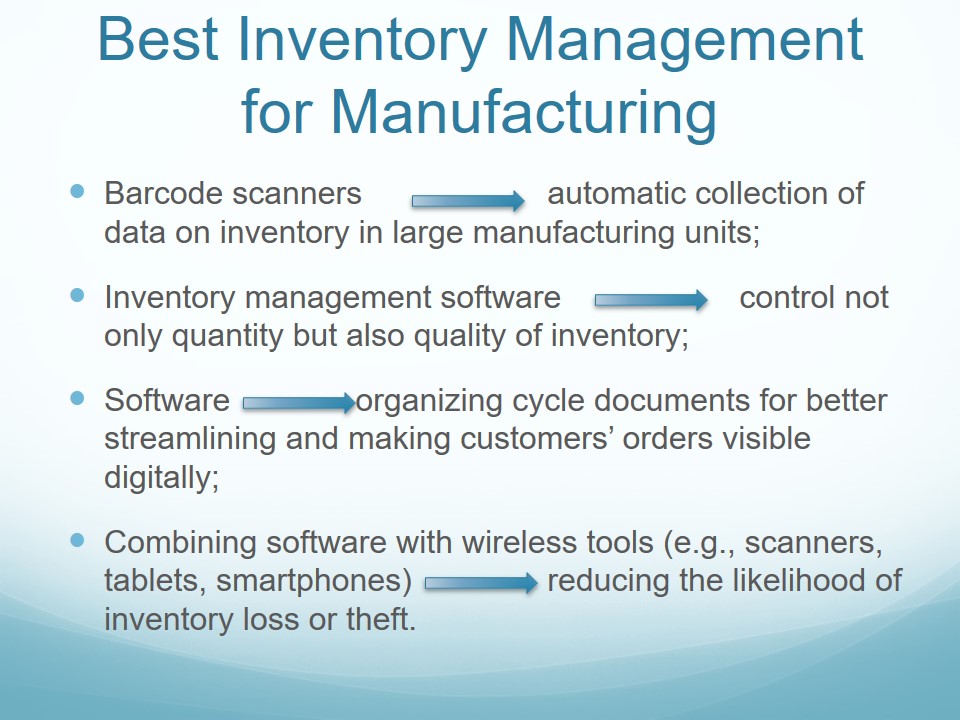
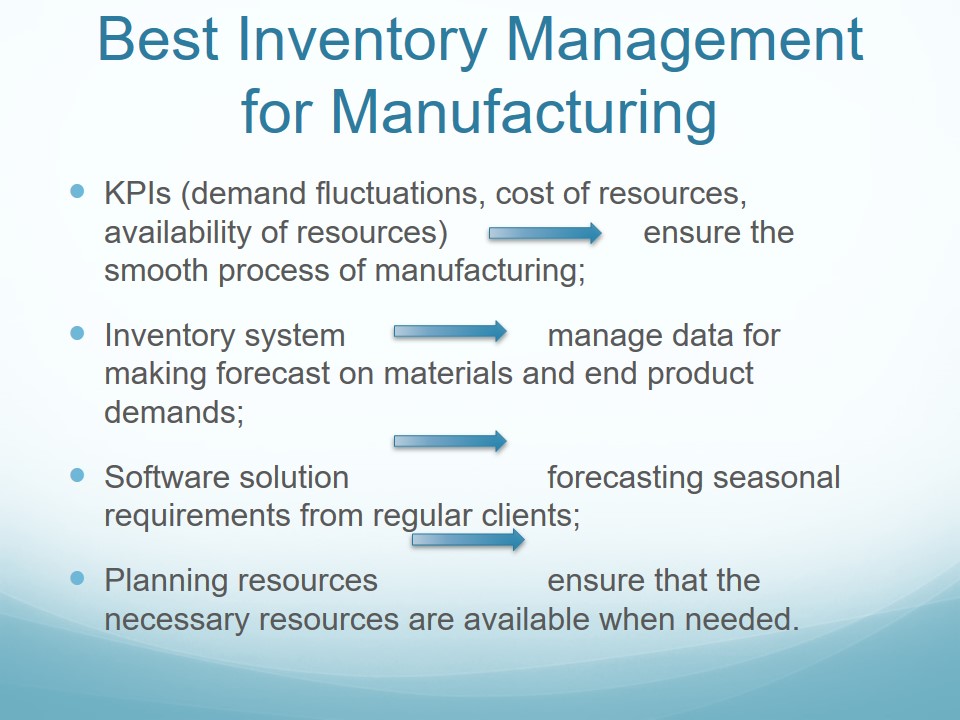
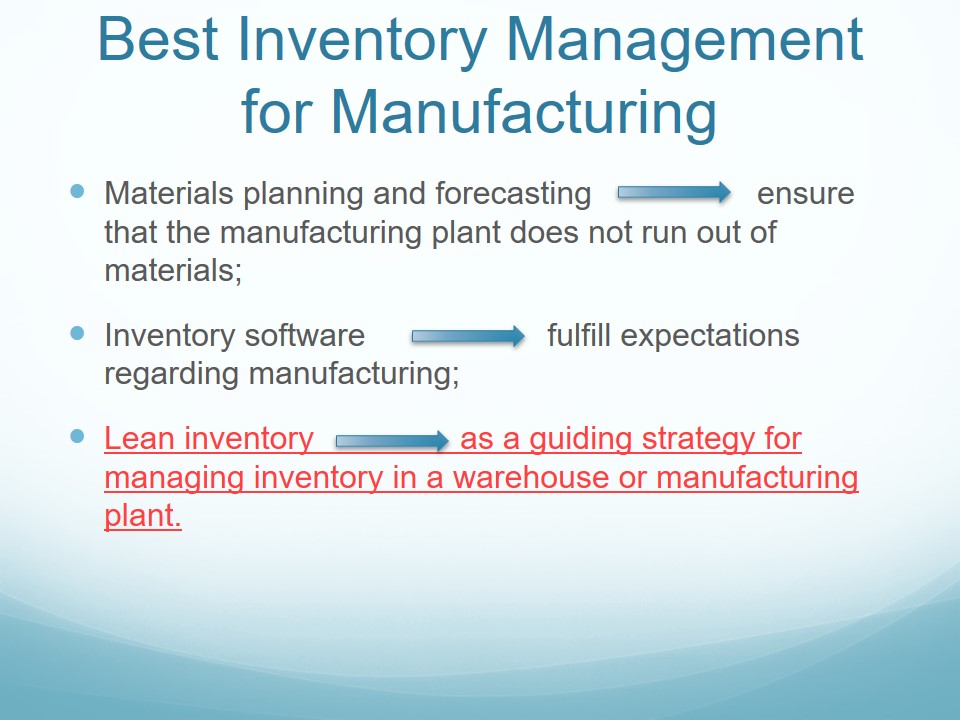
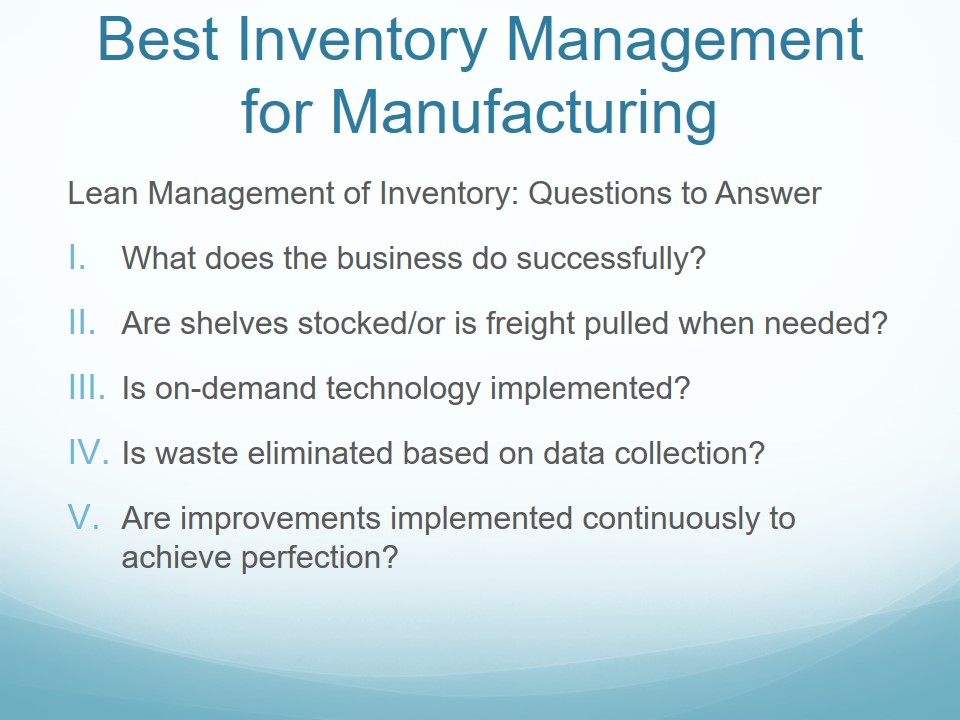
Materials requirement planning
- Information systems for improving productivity:
- Making forecasts for scheduling materials flow, labor units, sales, etc.
- Calculating dependent demand
- Making critical decisions about production.
- Improving prediction efficiency through the use of software technology.
- Working backward using a production plan and developing specific requirements on the use of raw materials (“Materials requirements planning (MRP),” 2016).
- Purchasing/developing materials requirement planning software for measuring the following KPIs: Sales and purchase orders, Forecasts and due dates; Inventory, materials, data, etc.
- Steps for materials requirement planning:
- Identification of quantity requirements;
- Doing MRP calculations for making suggestions about necessary materials (“Not just for manufacturing,” 2016);
- Completing customer orders.
In the context of manufacturing, materials requirement planning implies the use of information technology software that makes it possible for businesses to improve their productivity. Software will allow manufacturers to make clear decisions about the production of their products and improve the efficiency of forecasts and predictions to save money and time. Data on raw materials is used as a basis for the development of requirements that guide successful manufacturing.
It is essential to note that materials requirement planning through the use of the software will allow manufacturers to track the most important KPIs that make a difference when it comes to optimizing production and reducing costs. It is recommended for all manufacturers to use materials requirement planning through following such important steps as identifying the requirements of quantity, suggesting best practices about raw materials, and subsequently completing orders placed by customers (“Not just for manufacturing,” 2016).
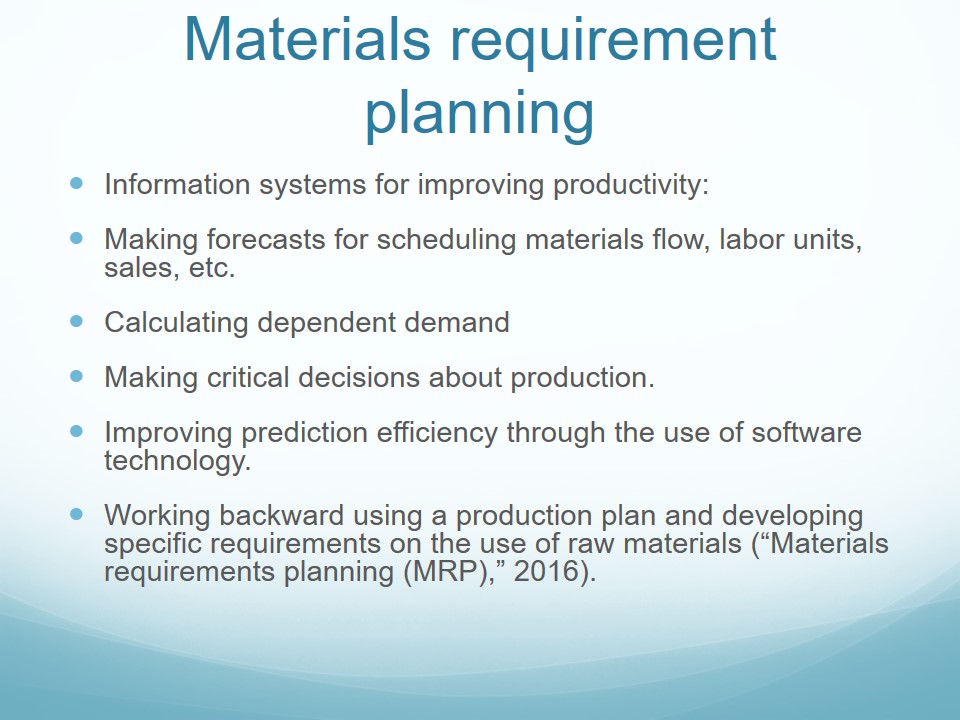
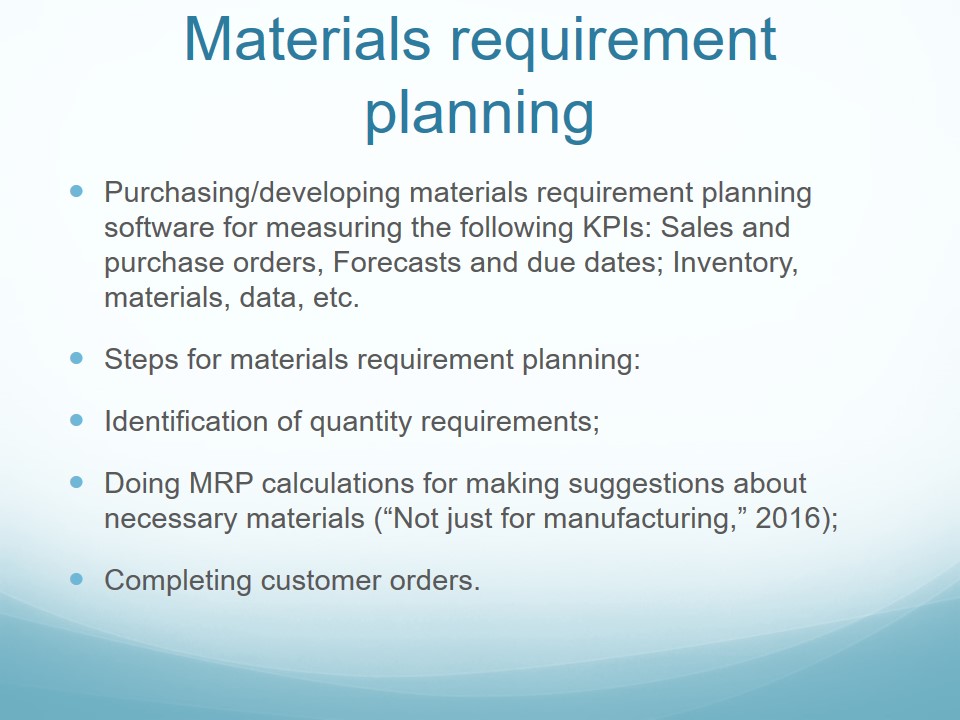
References
Fishbowl. (2018). An advanced inventory management system for an affordable price. Web.
Heizer, J., & Render, B. (2011). Operations management flexible version (10th ed.). London, UK: Pearson Education.
Marion, G. (2016). How to cycle count your inventory. Web.
Material requirements planning (MRP). (2016). Web.
Not just for manufacturing, material requirements planning (MRP) is indispensable for any business. (2016). Web.
Vinson, B. (2016). 6 inventory management best practices. Web.